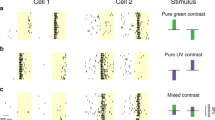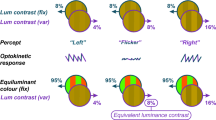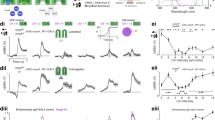Abstract
WE have colour vision because there are three types of cone photoreceptors which are maximally sensitive in the long (L), middle (M) and short (S) wavelength regions of the spectrum. Psychophysical experiments have, however, revealed mechanisms selectively responsive to light modulated in three 'cardinal directions' in colour space1. The responses of these mechanisms are determined by algebraic sums of the excitations of the cones. One of these mechanisms is responsive to changes in luminance, its spectral sensitivity being that of the sum of the L and M cones. The other two respond best to isoluminant changes in light. The responses of one of these mechanisms are determined by the difference in the excitations of the L and M cones, and those of the other one determined by the difference between the excitation of the S cones on the one hand and the excitations of the L and M cones on the other. We have obtained quite surprising results concerning the role of these mechanisms in the perception of motion. Drifting gratings modulated along different cardinal directions appear to slip with respect to one another. In contrast, when the directions of the modulations are rotated by 45° in colour space, the gratings cohere. Our results are consistent with the notion that information about movement is analysed within mechanisms maximally responsive along the cardinal directions.
This is a preview of subscription content, access via your institution
Access options
Subscribe to this journal
Receive 51 print issues and online access
$199.00 per year
only $3.90 per issue
Buy this article
- Purchase on Springer Link
- Instant access to full article PDF
Prices may be subject to local taxes which are calculated during checkout
Similar content being viewed by others
References
Krauskopf, J., Williams, D. R. & Heeley, D. W. Vision Res. 22, 1121–1131 (1982).
Adelson, E. H. & Movshon, J. A. Nature 300, 523–525 (1982).
MacLeod, D. I. A. & Boynton, R. M. J. opt. Soc. Am. 69, 1183–1186 (1978).
Wiesel, T. N. & Hubel, D. H. J. Neumphysiol. 29, 1115–1156 (1966).
DeValois, R. L., Abramov, I. & Jacobs, G. H. J. opt. Soc. Am. 56, 966–977 (1966).
Derrington, A. M., Krauskopf, J. & Lennie, P. J. Physiol. Lond. 357, 241–265 (1984).
Krauskopf, J., Williams, D. R., Mandler, M. B. & Brown, A. M. Vision Res. 26, 23–32 (1986).
Livingstone, M. S. & Hubel, D. H. J. Neurosci. 7, 3416–3468 (1987).
Lennie, P., Krauskopf, J. & Sclar, G. J. Neurosci. 10, 649–669 (1990).
Author information
Authors and Affiliations
Rights and permissions
About this article
Cite this article
Krauskopf, J., Farell, B. Influence of colour on the perception of coherent motion. Nature 348, 328–331 (1990). https://doi.org/10.1038/348328a0
Received:
Accepted:
Issue Date:
DOI: https://doi.org/10.1038/348328a0
Comments
By submitting a comment you agree to abide by our Terms and Community Guidelines. If you find something abusive or that does not comply with our terms or guidelines please flag it as inappropriate.



